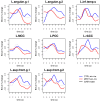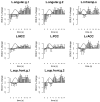"Thinking about not-thinking": neural correlates of conceptual processing during Zen meditation - PubMed (original) (raw)
"Thinking about not-thinking": neural correlates of conceptual processing during Zen meditation
Giuseppe Pagnoni et al. PLoS One. 2008.
Abstract
Recent neuroimaging studies have identified a set of brain regions that are metabolically active during wakeful rest and consistently deactivate in a variety the performance of demanding tasks. This "default network" has been functionally linked to the stream of thoughts occurring automatically in the absence of goal-directed activity and which constitutes an aspect of mental behavior specifically addressed by many meditative practices. Zen meditation, in particular, is traditionally associated with a mental state of full awareness but reduced conceptual content, to be attained via a disciplined regulation of attention and bodily posture. Using fMRI and a simplified meditative condition interspersed with a lexical decision task, we investigated the neural correlates of conceptual processing during meditation in regular Zen practitioners and matched control subjects. While behavioral performance did not differ between groups, Zen practitioners displayed a reduced duration of the neural response linked to conceptual processing in regions of the default network, suggesting that meditative training may foster the ability to control the automatic cascade of semantic associations triggered by a stimulus and, by extension, to voluntarily regulate the flow of spontaneous mentation.
Conflict of interest statement
Competing Interests: The authors have declared that no competing interests exist.
Figures
Figure 1. Activated clusters for the contrast words-nonwords on the pooled data (CTRL+MEDT).
The _t_-map is thresholded at p<0.001, _k_>27 voxels (α<0.05).
Figure 2. ROI-based averages of the Gamma model beta coefficients for words (“wo”) and nonwords (“nw”) in controls (CTRL) and meditators (MEDT).
Abbreviations for ROI names are the same as in Table 2, where the index 1 and 2 for clusters with the same anatomical label follows the order in the table.
Figure 3. Estimates of the BOLD response associated with semantic processing in the ROI set, obtained by fitting a spline basis set model for the hemodynamic function and subtracting the average response to nonwords (“nw”) from the average response to words (“wo”) in meditators and controls.
The Gamma function model for a standard hemodynamic response is plotted as a black dotted line for reference.
Figure 4. Difference between controls and meditators (CTRL-MEDT) in the estimated profile of the BOLD response related to conceptual activity.
Error bars represent standard errors and a reference Gamma function model for the BOLD response to a single brief stimulus is plotted as a black line for reference.
Similar articles
- Distinct neural activity associated with focused-attention meditation and loving-kindness meditation.
Lee TM, Leung MK, Hou WK, Tang JC, Yin J, So KF, Lee CF, Chan CC. Lee TM, et al. PLoS One. 2012;7(8):e40054. doi: 10.1371/journal.pone.0040054. Epub 2012 Aug 15. PLoS One. 2012. PMID: 22905090 Free PMC article. - Meditation leads to reduced default mode network activity beyond an active task.
Garrison KA, Zeffiro TA, Scheinost D, Constable RT, Brewer JA. Garrison KA, et al. Cogn Affect Behav Neurosci. 2015 Sep;15(3):712-20. doi: 10.3758/s13415-015-0358-3. Cogn Affect Behav Neurosci. 2015. PMID: 25904238 Free PMC article. - Meditation attenuates default-mode activity: A pilot study using ultra-high field 7 Tesla MRI.
Ganesan S, A Moffat B, Van Dam NT, Lorenzetti V, Zalesky A. Ganesan S, et al. Brain Res Bull. 2023 Oct 15;203:110766. doi: 10.1016/j.brainresbull.2023.110766. Epub 2023 Sep 19. Brain Res Bull. 2023. PMID: 37734622 - Zen meditation: an integration of current evidence.
Chiesa A. Chiesa A. J Altern Complement Med. 2009 May;15(5):585-92. doi: 10.1089/acm.2008.0416. J Altern Complement Med. 2009. PMID: 19422285 Review. - [The history of Mindfulness put to the test of current scientific data: unresolved questions].
Trousselard M, Steiler D, Claverie D, Canini F. Trousselard M, et al. Encephale. 2014 Dec;40(6):474-80. doi: 10.1016/j.encep.2014.08.006. Epub 2014 Sep 5. Encephale. 2014. PMID: 25194754 Review. French.
Cited by
- Post-stroke fatigue: a review of development, prevalence, predisposing factors, measurements, and treatments.
Chen W, Jiang T, Huang H, Zeng J. Chen W, et al. Front Neurol. 2023 Dec 21;14:1298915. doi: 10.3389/fneur.2023.1298915. eCollection 2023. Front Neurol. 2023. PMID: 38187145 Free PMC article. Review. - A systematic review and activation likelihood estimation meta-analysis of fMRI studies on arousing or wake-promoting effects in Buddhist meditation.
Chaudhary IS, Shyi GC, Huang ST. Chaudhary IS, et al. Front Psychol. 2023 Oct 27;14:1136983. doi: 10.3389/fpsyg.2023.1136983. eCollection 2023. Front Psychol. 2023. PMID: 38022985 Free PMC article. - Eliciting brain waves of people with cognitive impairment during meditation exercises using portable electroencephalography in a smart-home environment: a pilot study.
Lazarou I, Oikonomou VP, Mpaltadoros L, Grammatikopoulou M, Alepopoulos V, Stavropoulos TG, Bezerianos A, Nikolopoulos S, Kompatsiaris I, Tsolaki M; RADAR-AD Consortium. Lazarou I, et al. Front Aging Neurosci. 2023 May 30;15:1167410. doi: 10.3389/fnagi.2023.1167410. eCollection 2023. Front Aging Neurosci. 2023. PMID: 37388185 Free PMC article. - Contrasting Electroencephalography-Derived Entropy and Neural Oscillations With Highly Skilled Meditators.
Young JH, Arterberry ME, Martin JP. Young JH, et al. Front Hum Neurosci. 2021 Apr 30;15:628417. doi: 10.3389/fnhum.2021.628417. eCollection 2021. Front Hum Neurosci. 2021. PMID: 33994976 Free PMC article. - Meditation affects word recognition of meditation novices.
Lusnig L, Radach R, Hofmann MJ. Lusnig L, et al. Psychol Res. 2022 Apr;86(3):723-736. doi: 10.1007/s00426-021-01522-5. Epub 2021 May 9. Psychol Res. 2022. PMID: 33966104 Free PMC article.
References
- Barinaga M. Buddhism and neuroscience. Studying the well-trained mind. Science. 2003;302:44–46. - PubMed
- Knight J. Religion and science: Buddhism on the brain. Nature. 2004;432:670. - PubMed
- Nishitani K. Religion and Nothingness. Berkeley: University of California Press; 1982.
- Kim H-J. Eihei Dogen: Mystical Realist. London: Wisdom Publications; 2004.
- Lutz A, Dunne JD, Davidson RJ. The Cambridge Handbook of Consciousness. In: Zelazo P, Moscovitch M, Thompson E, editors. Cambridge University Press; 2007.
Publication types
MeSH terms
Grants and funding
- P30 AT000609/AT/NCCIH NIH HHS/United States
- R01 MH079251/MH/NIMH NIH HHS/United States
- R01 MH079251-02/MH/NIMH NIH HHS/United States
- P30-AT00609/AT/NCCIH NIH HHS/United States
LinkOut - more resources
Full Text Sources
Other Literature Sources



